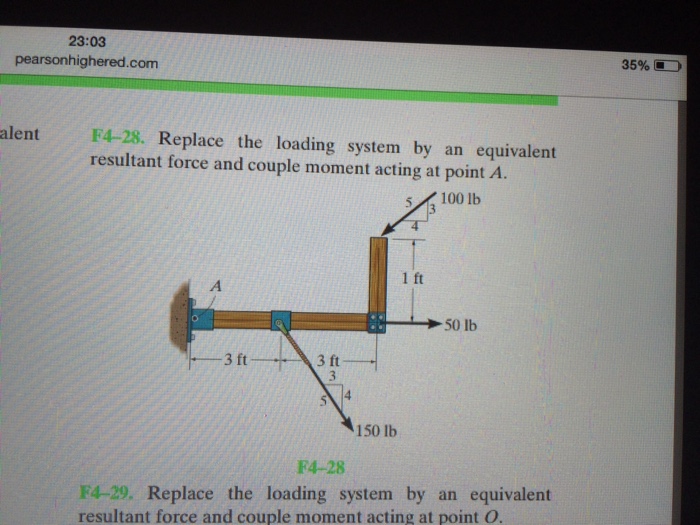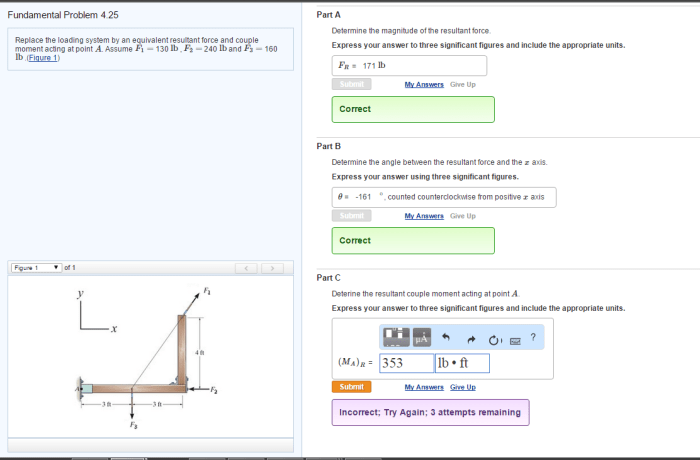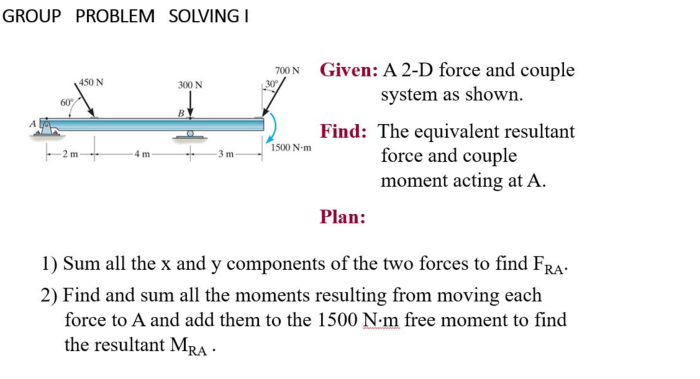Replace the loading system by an equivalent resultant force – In the realm of structural analysis and engineering design, the concept of replacing a loading system with an equivalent resultant force holds immense significance. This operation simplifies the analysis of complex loading systems, enabling engineers to evaluate structures and components with greater efficiency and accuracy.
This guide delves into the methods, applications, advantages, and limitations of this fundamental technique, providing a comprehensive understanding for practitioners and students alike.
By replacing a distributed load with a single force or determining the resultant force graphically, engineers can simplify the analysis of complex loading systems, making it more manageable and efficient. This approach finds widespread application in bridge design, building construction, and other engineering disciplines, contributing to the safety and integrity of structures.
Introduction

Replacing a loading system with an equivalent resultant force is a technique used in engineering to simplify the analysis of complex loading systems. It involves representing a distributed load or a system of multiple forces acting on a structure or component with a single force that produces the same effect.
This operation is significant because it allows engineers to reduce the complexity of the loading system, making it easier to determine the stresses and deformations in the structure. It also helps in optimizing the design of structures and components by ensuring that they can withstand the applied loads without failure.
Methods for Replacing a Loading System

Using a Single Force to Replace a Distributed Load
This method involves replacing a distributed load, such as a uniform pressure or a moment, with a single force that has the same resultant effect. The magnitude of the force is equal to the total load, and its point of application is determined based on the distribution of the load.
Graphical Method of Determining the Resultant Force
This method involves graphically determining the resultant force by constructing a force polygon. The forces are represented as vectors, and the resultant force is the vector that closes the polygon. This method is particularly useful for systems with multiple forces acting in different directions.
Examples of Applying These Methods
- Replacing a uniform pressure acting on a beam with a single force at the centroid of the beam
- Determining the resultant force of a system of forces acting on a truss using a force polygon
Applications of Equivalent Resultant Force

Analyzing Structures and Components
Equivalent resultant force is widely used in analyzing structures and components subjected to complex loading systems. It allows engineers to simplify the analysis by reducing the number of forces that need to be considered.
Simplifying Analysis of Complex Loading Systems
By replacing a complex loading system with an equivalent resultant force, engineers can simplify the analysis process. This is particularly useful for structures subjected to multiple loads acting in different directions, such as bridges and buildings.
Examples of Use in Bridge Design and Building Construction
- Determining the resultant force of wind loads on a bridge
- Calculating the equivalent resultant force of seismic loads on a building
Advantages and Limitations: Replace The Loading System By An Equivalent Resultant Force

Advantages of Using an Equivalent Resultant Force
- Simplifies analysis by reducing the number of forces to be considered
- Makes it easier to determine the stresses and deformations in the structure
- Helps in optimizing the design of structures and components
Limitations of This Approach, Replace the loading system by an equivalent resultant force
- May lead to inaccuracies in certain cases, especially when the loading system is highly complex
- Requires careful consideration of the distribution of the load when determining the point of application of the resultant force
Recommendations for Use
The equivalent resultant force method is recommended when the loading system is relatively simple and when the distribution of the load is well-defined. For more complex loading systems, alternative approaches, such as finite element analysis, may be more appropriate.
FAQ
What is the purpose of replacing a loading system with an equivalent resultant force?
Replacing a loading system with an equivalent resultant force simplifies the analysis of complex loading systems, making it more manageable and efficient.
How can a distributed load be replaced with a single force?
Using the principle of equilibrium, a distributed load can be replaced with a single force acting at the centroid of the loaded area.
What are the advantages of using an equivalent resultant force?
The advantages include simplification of analysis, improved efficiency, and ease of application in engineering design.
What are the limitations of using an equivalent resultant force?
Limitations include potential inaccuracies in certain cases, such as when the loading system is highly non-uniform or when considering dynamic effects.